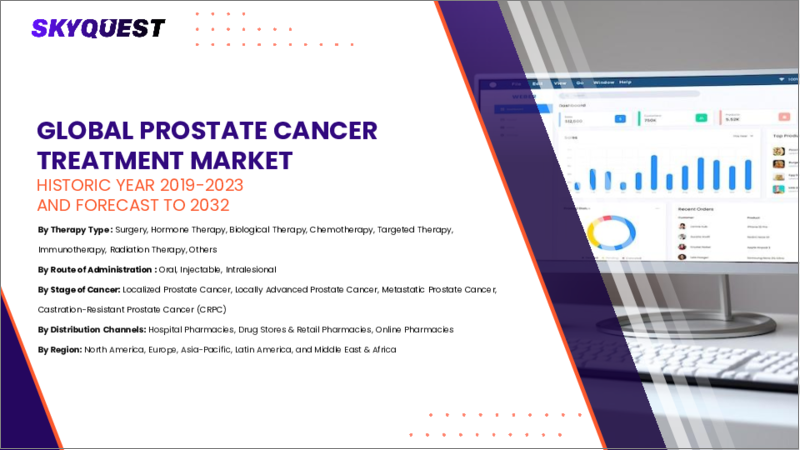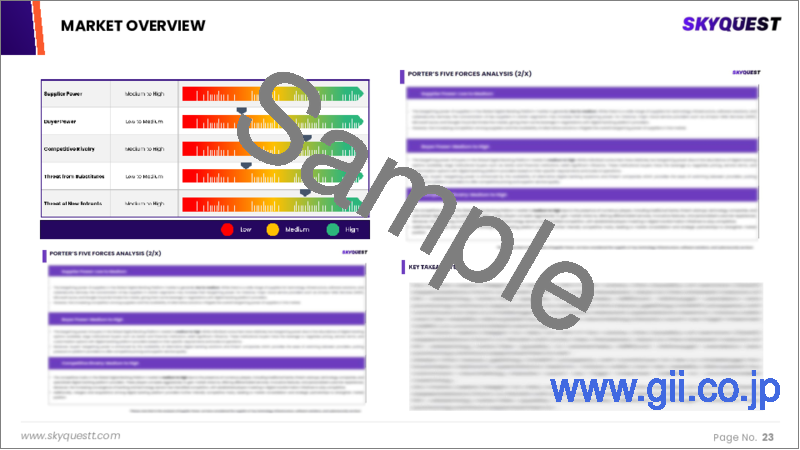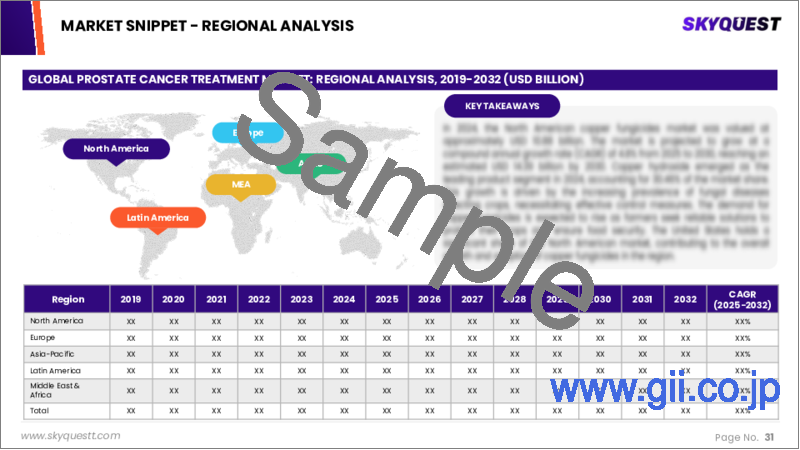|
|
市場調査レポート
商品コード
1653948
前立腺がん治療市場規模、シェア、成長分析:薬の種類別、流通チャネル別、地域別 - 産業予測 2025~2032年Prostate Cancer Treatment Market Size, Share, and Growth Analysis, By Drug Type, By Distribution Channel, By Region - Industry Forecast 2025-2032 |
||||||
|
|||||||
| 前立腺がん治療市場規模、シェア、成長分析:薬の種類別、流通チャネル別、地域別 - 産業予測 2025~2032年 |
|
出版日: 2025年02月09日
発行: SkyQuest
ページ情報: 英文 157 Pages
納期: 3~5営業日
|
全表示
- 概要
- 目次
前立腺がん治療市場規模は2023年に121億米ドルと評価され、予測期間(2025-2032年)のCAGRは7.9%で、2024年の130億6,000万米ドルから2032年には239億9,000万米ドルに成長する見通しです。
世界の市場情勢は、高齢化、意識の高まり、早期診断による男性の前立腺がん罹患率の増加が主な要因となって、活気に満ちた進化を遂げています。この罹患率の急増は、革新的な治療法の開発を促進します。しかし、高額な治療費や潜在的な副作用といった課題が、より広範な普及を妨げる可能性があります。主な成長要因としては、医薬品の選択肢の増加、多額の研究開発投資、複雑なパイプライン医薬品の導入、非転移性去勢抵抗性および転移性ホルモン非依存性病態の両方におけるホルモン療法の拡大などが挙げられます。新興経済諸国における未開拓のビジネスチャンスは、治癒期間と需要に若干の制約はあるもの、この市場をさらに推進する可能性があります。個別化治療戦略へのシフトと薬剤ターゲティングの強化が今後の進歩の原動力となり、患者の転帰を大幅に改善する可能性が高いです。
目次
イントロダクション
- 調査の目的
- 調査範囲
- 定義
調査手法
- 情報調達
- 二次と一次データの方法
- 市場規模予測
- 市場の前提条件と制限
エグゼクティブサマリー
- 世界市場の見通し
- 供給と需要の動向分析
- セグメント別機会分析
市場力学と見通し
- 市場概要
- 市場規模
- 市場力学
- 促進要因と機会
- 抑制要因と課題
- ポーターの分析
主な市場の考察
- 重要成功要因
- 競合の程度
- 主な投資機会
- 市場エコシステム
- 市場の魅力指数(2024年)
- PESTEL分析
- マクロ経済指標
- バリューチェーン分析
- 価格分析
- 規制情勢
- ケーススタディ
- 技術の進歩
前立腺がん治療市場規模:薬の種類別& CAGR(2025-2032)
- 市場概要
- ホルモン療法による前立腺がん治療
- 黄体形成ホルモン放出ホルモン(LHRH)拮抗薬
- ザイティガ
- ゴナックス
- 黄体形成ホルモン放出ホルモン(LHRH)作動薬
- ルプロン
- ゾラデックス
- エリガード
- デカペプチル
- ヴァンタス
- その他
- 抗アンドロゲン
- ザンディ
- カソデックス
- 前立腺がん化学療法
- タキソテール
- ジェフタナ
- 前立腺がん免疫療法
- プロベンジ
- 前立腺がん標的療法
- ゾフィゴ
- その他前立腺がん
前立腺がん治療市場規模:流通チャネル別& CAGR(2025-2032)
- 市場概要
- 病院薬局
- ドラッグストアと薬局
- オンライン薬局
前立腺がん治療市場規模:地域別& CAGR(2025-2032)
- 北米
- 米国
- カナダ
- 欧州
- ドイツ
- スペイン
- フランス
- 英国
- イタリア
- その他欧州地域
- アジア太平洋地域
- 中国
- インド
- 日本
- 韓国
- その他アジア太平洋地域
- ラテンアメリカ
- ブラジル
- その他ラテンアメリカ地域
- 中東・アフリカ
- GCC諸国
- 南アフリカ
- その他中東・アフリカ
競合情報
- 上位5社の比較
- 主要企業の市場ポジショニング(2024年)
- 主な市場企業が採用した戦略
- 最近の市場動向
- 企業の市場シェア分析(2024年)
- 主要企業の企業プロファイル
- 企業の詳細
- 製品ポートフォリオ分析
- 企業のセグメント別シェア分析
- 収益の前年比比較(2022-2024)
主要企業プロファイル
- AbbVie Inc.(USA)
- Amgen Inc.(USA)
- GSK Plc(UK)
- Merck KGaA(Germany)
- Viatris Inc.(USA)
- Novartis AG(Switzerland)
- Pfizer Inc.(USA)
- Takeda Pharmaceutical Company Limited(Japan)
- Exelixis Inc.(USA)
- IBSA Pharma(IBSA Group)(Switzerland)
- Abbott Laboratories(USA)
- Alvogen Iceland ehf(Iceland)
- Fresenius SE & Co. KGaA(Germany)
- Jerome Stevens Pharmaceuticals Inc.(USA)
- Lannett Co. Inc.(USA)
- Lupin Ltd.(India)
- Mayne Pharma Group Ltd.(Australia)
- Piramal Enterprises Ltd.(India)
- RLC Labs Inc.(USA)
- Sun Pharmaceutical Industries Ltd.(India)
結論と提言
Prostate Cancer Treatment Market size was valued at USD 12.1 billion in 2023 and is poised to grow from USD 13.06 billion in 2024 to USD 23.99 billion by 2032, growing at a CAGR of 7.9% during the forecast period (2025-2032).
The global prostate cancer treatment market presents a vibrant and evolving landscape, primarily driven by the increasing prevalence of prostate cancer among men due to an aging population, heightened awareness, and early diagnosis. This surge in incidence fosters the development of innovative treatments. However, challenges such as high treatment costs and potential side effects may hinder broader adoption. Key growth factors include the rise in pharmaceutical options, significant R&D investments, the introduction of complex pipeline drugs, and the expansion of hormonal therapies in both non-metastatic castration-resistant and metastatic hormone-naive conditions. Untapped opportunities in developing economies could further propel this market, albeit with some limitations in healing periods and demand. A shift toward personalized treatment strategies and enhanced drug targeting will likely drive future advancements, improving patient outcomes significantly.
Top-down and bottom-up approaches were used to estimate and validate the size of the Prostate Cancer Treatment market and to estimate the size of various other dependent submarkets. The research methodology used to estimate the market size includes the following details: The key players in the market were identified through secondary research, and their market shares in the respective regions were determined through primary and secondary research. This entire procedure includes the study of the annual and financial reports of the top market players and extensive interviews for key insights from industry leaders such as CEOs, VPs, directors, and marketing executives. All percentage shares split, and breakdowns were determined using secondary sources and verified through Primary sources. All possible parameters that affect the markets covered in this research study have been accounted for, viewed in extensive detail, verified through primary research, and analyzed to get the final quantitative and qualitative data.
Prostate Cancer Treatment Market Segments Analysis
Global Prostate Cancer Treatment Market is segmented by Drug Type, Distribution Channel and region. Based on Drug Type, the market is segmented into Hormonal Prostate Cancer Therapy, Prostate Cancer Chemotherapy, Prostate Cancer Immunotherapy, Prostate Cancer Targeted Therapy and Others Prostate Cancer. Based on Distribution Channel, the market is segmented into Hospitals Pharmacies, Drug Stores & Retail Pharmacies and Online Pharmacies. Based on region, the market is segmented into North America, Europe, Asia Pacific, Latin America and Middle East & Africa.
Driver of the Prostate Cancer Treatment Market
The Prostate Cancer Treatment market is primarily driven by the rising prevalence of prostate cancer, which is influenced by various factors such as an aging global population and advancements in awareness and diagnostic techniques. As the population ages, it is expected that prostate cancer incidence will rise significantly, particularly since the disease predominantly affects older men. Enhanced awareness and widespread screening initiatives have contributed to the earlier detection of prostate cancer, leading to increased reported cases. These elements highlight the pressing need for effective treatment options and foster the development of innovative therapies within this dynamic market.
Restraints in the Prostate Cancer Treatment Market
The global market for prostate cancer treatment encounters notable obstacles, primarily due to the substantial costs linked to targeted therapies and immunotherapies. While these advanced treatment options have demonstrated significant potential for enhancing patient outcomes, their affordability poses a serious challenge. The expenses associated with therapies like immunosuppressants can be exceedingly high, imposing a considerable financial strain on both patients and healthcare systems. This elevated cost frequently restricts access to these crucial therapies, hindering the ability to provide effective care. A limited number of patients worldwide face the difficult task of managing the financial implications, highlighting the urgent need to address cost-related barriers to ensure wider access to these potentially life-saving treatments.
Market Trends of the Prostate Cancer Treatment Market
The prostate cancer treatment market is increasingly trending towards personalized medicine, highlighting a shift towards tailored therapeutic strategies based on individual genetic and molecular profiles. Advances in genomic testing allow for the identification of specific biomarkers, enabling healthcare providers to select the most effective treatment options while minimizing unnecessary interventions and side effects. Technologies such as the Prostate Health Index and genomic tests like Oncotype DX are at the forefront of this transformation. Furthermore, targeted therapies like olaparib and rucaparib are becoming critical in treating advanced cases by addressing DNA repair pathway alterations, enhancing the overall efficacy of prostate cancer management.
Table of Contents
Introduction
- Objectives of the Study
- Scope of the Report
- Definitions
Research Methodology
- Information Procurement
- Secondary & Primary Data Methods
- Market Size Estimation
- Market Assumptions & Limitations
Executive Summary
- Global Market Outlook
- Supply & Demand Trend Analysis
- Segmental Opportunity Analysis
Market Dynamics & Outlook
- Market Overview
- Market Size
- Market Dynamics
- Drivers & Opportunities
- Restraints & Challenges
- Porters Analysis
- Competitive rivalry
- Threat of substitute
- Bargaining power of buyers
- Threat of new entrants
- Bargaining power of suppliers
Key Market Insights
- Key Success Factors
- Degree of Competition
- Top Investment Pockets
- Market Ecosystem
- Market Attractiveness Index, 2024
- PESTEL Analysis
- Macro-Economic Indicators
- Value Chain Analysis
- Pricing Analysis
- Regulatory Landscape
- Case Studies
- Technological Advancement
Global Prostate Cancer Treatment Market Size by Drug Type & CAGR (2025-2032)
- Market Overview
- Hormonal Prostate Cancer Therapy
- Luteinizing Hormone-Releasing Hormone (LHRH) Antagonists
- Zytiga
- Gonax
- Luteinizing Hormone-Releasing Hormone (LHRH) Agonists
- Lupron
- Zoladex
- Eligard
- Decapeptyl
- Vantas
- Others
- Anti-Androgen
- Xtandi
- Casodex
- Prostate Cancer Chemotherapy
- Taxotere
- Jevtana
- Prostate Cancer Immunotherapy
- Provenge
- Prostate Cancer Targeted Therapy
- Xofigo
- Others Prostate Cancer
Global Prostate Cancer Treatment Market Size by Distribution Channel & CAGR (2025-2032)
- Market Overview
- Hospitals Pharmacies
- Drug Stores & Retail Pharmacies
- Online Pharmacies
Global Prostate Cancer Treatment Market Size & CAGR (2025-2032)
- North America (Drug Type, Distribution Channel)
- US
- Canada
- Europe (Drug Type, Distribution Channel)
- Germany
- Spain
- France
- UK
- Italy
- Rest of Europe
- Asia Pacific (Drug Type, Distribution Channel)
- China
- India
- Japan
- South Korea
- Rest of Asia-Pacific
- Latin America (Drug Type, Distribution Channel)
- Brazil
- Rest of Latin America
- Middle East & Africa (Drug Type, Distribution Channel)
- GCC Countries
- South Africa
- Rest of Middle East & Africa
Competitive Intelligence
- Top 5 Player Comparison
- Market Positioning of Key Players, 2024
- Strategies Adopted by Key Market Players
- Recent Developments in the Market
- Company Market Share Analysis, 2024
- Company Profiles of All Key Players
- Company Details
- Product Portfolio Analysis
- Company's Segmental Share Analysis
- Revenue Y-O-Y Comparison (2022-2024)
Key Company Profiles
- AbbVie Inc. (USA)
- Company Overview
- Business Segment Overview
- Financial Updates
- Key Developments
- Amgen Inc. (USA)
- Company Overview
- Business Segment Overview
- Financial Updates
- Key Developments
- GSK Plc (UK)
- Company Overview
- Business Segment Overview
- Financial Updates
- Key Developments
- Merck KGaA (Germany)
- Company Overview
- Business Segment Overview
- Financial Updates
- Key Developments
- Viatris Inc. (USA)
- Company Overview
- Business Segment Overview
- Financial Updates
- Key Developments
- Novartis AG (Switzerland)
- Company Overview
- Business Segment Overview
- Financial Updates
- Key Developments
- Pfizer Inc. (USA)
- Company Overview
- Business Segment Overview
- Financial Updates
- Key Developments
- Takeda Pharmaceutical Company Limited (Japan)
- Company Overview
- Business Segment Overview
- Financial Updates
- Key Developments
- Exelixis Inc. (USA)
- Company Overview
- Business Segment Overview
- Financial Updates
- Key Developments
- IBSA Pharma (IBSA Group) (Switzerland)
- Company Overview
- Business Segment Overview
- Financial Updates
- Key Developments
- Abbott Laboratories (USA)
- Company Overview
- Business Segment Overview
- Financial Updates
- Key Developments
- Alvogen Iceland ehf (Iceland)
- Company Overview
- Business Segment Overview
- Financial Updates
- Key Developments
- Fresenius SE & Co. KGaA (Germany)
- Company Overview
- Business Segment Overview
- Financial Updates
- Key Developments
- Jerome Stevens Pharmaceuticals Inc. (USA)
- Company Overview
- Business Segment Overview
- Financial Updates
- Key Developments
- Lannett Co. Inc. (USA)
- Company Overview
- Business Segment Overview
- Financial Updates
- Key Developments
- Lupin Ltd. (India)
- Company Overview
- Business Segment Overview
- Financial Updates
- Key Developments
- Mayne Pharma Group Ltd. (Australia)
- Company Overview
- Business Segment Overview
- Financial Updates
- Key Developments
- Piramal Enterprises Ltd. (India)
- Company Overview
- Business Segment Overview
- Financial Updates
- Key Developments
- RLC Labs Inc. (USA)
- Company Overview
- Business Segment Overview
- Financial Updates
- Key Developments
- Sun Pharmaceutical Industries Ltd. (India)
- Company Overview
- Business Segment Overview
- Financial Updates
- Key Developments






